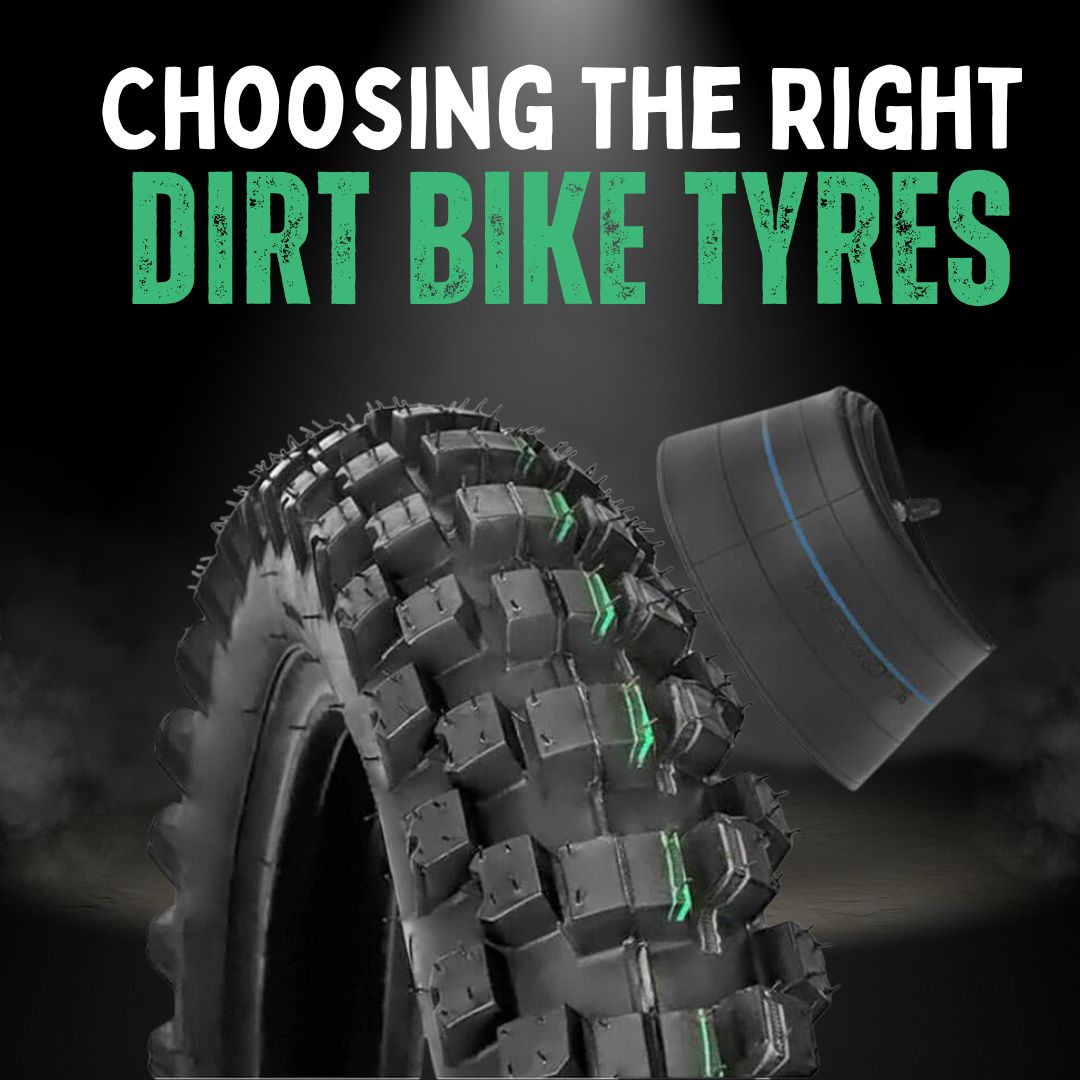
Updated: 25.4.25
Dirt biking combines adventure, skill, and the thrill of mastering diverse terrains. But success starts with one crucial choice — your tyres.
Picking the wrong tyres can turn an exciting ride into a struggle, while the right ones enhance safety, grip, and control. In this guide, we’ll explore how to choose the best dirt biking tyres for different terrains, riding styles, and conditions.
Understanding Terrain Types and Their Ideal Tyres
Hard Terrain Tyres
Perfect for firm surfaces, these tyres feature closely spaced lugs for maximum stability and control on hard-packed tracks.
Intermediate Terrain Tyres
The all-rounders. Intermediate tyres offer a balance between grip and durability, ideal for riders tackling varied conditions.
Soft Terrain Tyres
Designed for sand and mud, these tyres use widely spaced knobs to prevent clogging and boost traction on loose surfaces.
The Importance of Tyre Size and Width
Tyre Width and Terrain Suitability
Wider tyres offer better traction on loose, uneven surfaces. Narrower options are ideal for speed and agility on firm terrain.
Tyre Categories and Adaptation
Hard, intermediate, and soft terrain tyres vary in width and tread design to match their intended use. Choose wisely based on where you ride most.
Tyre Width and Riding Style
Cross-country racers often prefer narrower tyres for speed, while trail and enduro riders benefit from wider tyres for stability and grip.
Tyre Sizing and Performance
Correct sizing affects rolling resistance, traction, steering, and puncture protection. Match your tyre size to your bike, style, and terrain needs.
Tyre Tread Patterns and Performance
Tyre lugs and knob designs are carefully engineered for specific conditions. Understanding tread patterns helps maximise grip and handling.
Tyre Compounds
Soft-compound tyres offer superior grip but wear faster. Hard-compound tyres last longer but may sacrifice some traction. Choose based on your priorities.
How Tyre Pressure Impacts Dirt Biking
Grip and Handling
Overinflated tyres reduce grip, while underinflated ones can cause sluggish handling. Find the sweet spot for your weight, terrain, and bike.
Optimising Performance
Proper pressure boosts grip, extends tyre life, improves safety, and enhances fuel efficiency.
Tyre Wear and Fuel Economy
Maintaining correct tyre pressure ensures even wear and optimises fuel economy over time.
Sensitivity to Changes
Small pressure deviations can dramatically impact performance. Adjust based on weather and terrain shifts.
Performance Driving
Racers and aggressive off-roaders often fine-tune pressures to match conditions and extract maximum performance.
Matching Tyres to Your Riding Style and Local Terrain
Whether you’re a trail explorer or a speed demon, your riding style and typical terrain should heavily influence your tyre selection.
Specialised Tyres and Expert Advice
Specialised options like Desert Knobbies and Paddle Tyres excel in niche conditions like dunes or deep sand. Expert insights help tailor your choice.
Seasonal Adjustments for Dirt Bike Tyres
Adapting to Weather
Seasonal changes can affect terrain. Wet conditions need tyres with wide, aggressive treads; dry, hard trails benefit from more durable compounds.
Winter Challenges
For snow or ice, use tyres with deeper treads — or even studded options — to maintain grip and stability.
Hot and Dry Conditions
In summer, hard compounds resist the wear caused by abrasive surfaces, preserving tyre life.
Seasonal Maintenance
Monitor tyre pressure more closely with changing temperatures. Inspect for damage after extreme rides.
Maintenance and Replacement Tips
No tyre lasts forever. Watch for signs of wear and replace promptly to maintain performance and safety.
Practical Tips for Testing and Selection
Testing Tyres
Demo events and test rides give real-world insights into how tyres handle different conditions.
Seek Expert Advice
Consult experienced riders or professionals for recommendations tailored to your terrain and style.
Balancing Cost and Quality
Higher-quality tyres cost more but offer superior performance, durability, and long-term value.
Regular Tyre Evaluation
Regularly assess your tyres’ performance and be ready to adjust your choice as your riding habits evolve.
Conclusion
Choosing the right dirt bike tyres is crucial for performance, safety, and adventure. Match your tyre type to your terrain, riding style, and local conditions to elevate your dirt biking experience.
Frequently Asked Questions
Can one set of tyres work all year round?
All-terrain tyres can work year-round in mild climates, but changing tyres seasonally improves performance in extreme conditions.
Does rider weight affect tyre choice?
Yes. Heavier riders often need slightly higher pressures to maintain traction and avoid squirming.
Are brand-name tyres really better?
Brand-name tyres often provide better grip, durability, and overall performance due to superior R&D investment.
Are there eco-friendly dirt bike tyres?
Eco-friendly tyre options using recycled materials are emerging. Research brands offering sustainable alternatives.
Get in Touch 🚀
Want more pro dirt biking tips? Explore RiiRoo.com or chat with our experts today!







Share:
The Evolution of Electric Dirt Bikes: From Past to Present
When Should Dirt Bike Tyres Be Replaced?